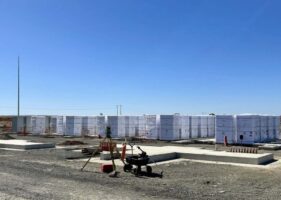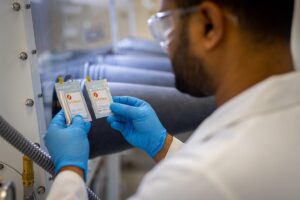This is the fifth article in a series on value-adding critical minerals opportunities in Australia. You can read the first, second, third and fourth installations here, here, here and here.
Critical minerals, and lithium and rare earths in particular, are becoming an increasingly large and crucial part of the global economy and the renewable energy transition, with its heavy reliance on wind turbines, EVs, and batteries.
The Albanese government is accelerating the growth in value-adding Australia’s critical minerals industry with the new National Critical Minerals Strategy announced on October 21, establishing a clear vision to unlock Australia’s critical minerals and renewable energy potential.
Operating alongside the $A2 billion Critical Minerals Facility, the new strategy includes a $1 billion Value Adding in Resources Fund and $50 million to establish the Australian Critical Minerals Research and Development Hub.
This federal government initiative, along with the Complementing the National Battery, Battery Recycling and the Electric Vehicle Strategies, will create regional jobs, boost exports, and help Australia take advantage of diversifying global supply chains.
Given the nature of the global technology race and supply chain security, particularly post Putin’s failing Ukraine invasion, public-private partnerships are an increasingly fundamental tool to support global clean energy supply chains, enabling key actors to secure and de-risk the supply of critical minerals.
De-risking projects and crowding-in access to private global debt and equity finance is critical for our resource value-adding manufacturers and refineries to reach full-scale production.
Public policies which enhance the investment environment and reduce the financial risks of new proposals will signal to investors and crowd-in private capital, accelerating investment.
Australia can leverage this enormous opportunity to build clean energy industry economies of scale by positioning minerals processing and manufacturing down-stream of its mining operations, providing geographic diversity to the concentration of global processing in China to-date.
With Australia’s abundant geological reserves and renewables potential, there is a mammoth opportunity to bring early and mid-stage downstream mineral processing back onshore.
As we discuss below, Australia’s allies have demonstrated the growing use of federal support in accelerating private capital inflows to scale and diversify their supply chains.
Convergence of public and private finance in North America
The United States’ Inflation Reduction Act of 2022 includes over $US60 billion to on-shore clean energy manufacturing, with the aim to mitigate risks of future price shocks, bring down the cost of clean energy and de-bottleneck supply chains:
- $30bn of production tax credits to accelerate US manufacturing solar panels, wind turbines, batteries, and critical minerals processing;
- $10bn investment tax credits to build clean manufacturing infrastructure for EVs, wind turbines, and solar panels;
- $500m into critical minerals processing in the Defence Production Act;
- $2bn to retool existing auto-manufacturing facilities to transition into clean vehicles; and
- Up to $20bn in loans to build new EV manufacturing facilities.
President Joe Biden signed the Inflation Reduction Act of 2022 into law on 16 August 2022, creating a substantial market signal for the transition of the battery supply chain into the US and potentially allied nations, including Canada and Australia.
“What we’re seeing is this unprecedented policy driver or policy signal layered on top of what was quickly becoming a ginormous market signal” – Aaron Brickman, Principal Rocky Mountain Institute.
The new climate change bill created a snowball of private investment into the US battery supply chain. Within a week, Volkswagen and Mercedes-Benz Group sealed agreements with the Canadian Government to secure supply chain stability for nickel, cobalt, and lithium for their manufacturing operations in the US.
After announcing their $US4 billion battery factory in Kansas, US, Panasonic began discussions to invest a further US$4bn to construct an additional facility in the states.
On August 29, 2022, Honda and LG Energy Solutions announced their intention to jointly invest $US4.4 billion for a new EV manufacturing facility in US. This investment was confirmed on October 12, with the companies committing a minimum $US3.5 billion into Ohio, creating at least 2,200 new jobs.
On October 19, 2022, the Biden Administration introduced the $US2.8bn Bipartisan Infrastructure Law, bringing significant federal support to 20 firms critical to the energy transition and onshoring supply chains. The facility will support the creation of more than 8,000 jobs, with 5,000 ongoing.
Among the selected projects, the Australian companies Syrah Resources (ASX:SYR), Novonix (ASX:NVX) and Piedmont Lithium (ASX:PLL) were granted $US511 million ($A816m) to deliver downstream lithium and graphite materials for domestic cell production. Following the Bipartisan Infrastructure Law announcement, Syrah, Novonix, and Piedmont share prices soared by 14%, 16%, and 9% respectively.
Additionally, the 2022 Canadian Budget contained significant support for supply chain security, with up to $C3.8 billion in support infrastructure investments to develop its Critical Minerals Strategy. The strategy was targeted towards projects prioritising manufacturing, processing, and recycling applications.
The Australian context
The scale of the clean energy investment pipeline is monumental. The IEA estimated clean energy investments at $US1.3 trillion in 2021. To reach global net zero emission targets, investment needs to more than triple by 2030.
In Australia, capturing the value of minerals processing pre-export is imperative to economic growth, with WA exporting 79% of global hard-rock lithium supply in 2021. The Western Australia government committed $A1.6 billion to establish midstream critical mineral projects in 2021-22.
Australia must now scale up the value chain through onshore processing of minerals including nickel, manganese, cobalt, lithium, aluminium and iron ore for economic, strategic and global decarbonisations reasons, and leverage our global competitive advantages by powering minerals processing with clean energy.
Figure 1 demonstrates the growing opportunity cost for Australia if we do not act.

In announcing the National Critical Minerals Strategy, Prime Minister Anthony Albanese said:
“Australia’s natural resources have powered our nation and we are committed to supporting the critical minerals sector and new clean technologies to reach our target of net zero, and make our nation an economic powerhouse with a clean energy future. Today’s new initiatives will ensure we can create and support local jobs, diversify global supply chains and meet the growing demand for batteries, EV and clean energy technology. These minerals will be critical to Australia achieving net zero emissions, and to helping the rest of the world make that transition as well.”
Resources Minister Madeleine King said:
“This package of measures demonstrates our commitment to net zero and the important role the resource sector can play in our energy transition. We are investing in the science and R&D collaborations. We are backing projects that are early to mid-stage, as well as helping fast-track financing for projects.”
As demonstrated by the rapid acceleration of private and public convergence in North America, and the efficacy of China’s state-backed initiatives, Australia’s first-loss capital vehicles are imperative to capturing this once in a lifetime opportunity to be a global critical mineral powerhouse.
In our next paper we review investment into critical mineral supply chain value-adding projects by key Australian public financial capital initiatives, including the Modern Manufacturing Initiative, Export Finance Australia, the Northern Australian Infrastructure Fund, the Australian Renewable Energy agency, the Clean Energy Finance Corporation and Queensland’s CleanCo.
With strategic investment, Australia is perfectly positioned to be a globally reliable renewable energy-powered critical minerals value-adding source, leveraging the booming electric vehicle and energy system decarbonisation trends that are accelerating in 2022 in response to the hyper-inflation of all things fossil fuel.
Tim Buckley is director of Climate Energy Finance. Matt Pollard is global EV supply chain analyst at Climate Energy Finance.
This analysis is for public interest purposes highlighting the national strategic interests and opportunities for Australia from the global energy transition. It should not be construed in any way as general nor specific financial advice.










